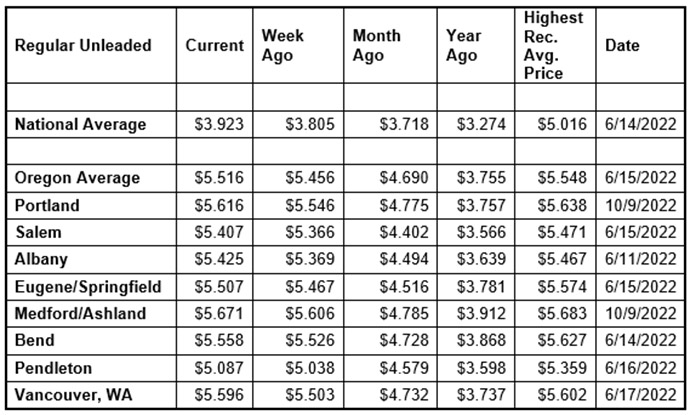Pump prices on the West Coast are finally settling down after three weeks of significant gains. Refineries in this region are coming back online after undergoing planned and unplanned maintenance.
This is helping to ease the severe supply crunch. However, higher crude oil prices continue to put upward pressure on gas prices. For the week, the national average for regular adds 11 cents to $3.92 a gallon. The Oregon average climbs six cents to $5.52. Oregon went from having the fifth-largest weekly jump for a state last week to the 41st largest increase this week.
The Oregon average came within a penny of reaching a new record high this month when it got to $5.54 a gallon. It has decreased slightly since then. Both the national and Oregon averages hit record highs in mid-June, then declined for 14 consecutive weeks before rising again for the last three weeks. The national average reached its record high of $5.016 on June 14 while the Oregon average reached its record high of $5.548 on June 15.
“Pump prices on the West Coast skyrocketed after at least six refineries in California went offline or were operating at reduced capacity. This put a major dent in supplies in this region. Our pump prices shot up and also put upward pressure on the national average for gas,” says Marie Dodds, public affairs director for AAA Oregon/Idaho. “The improving refinery situation and the switch to winter blend fuel should help ease the upward momentum in gas prices, as long as crude oil prices don’t see significant gains.”
The change from summer blend gas to winter blend gas normally puts downward pressure on pump prices because winter blend gas is cheaper to produce. Summer blend fuel is more environmentally friendly than winter blend. It has a lower Reid vapor pressure, which means it is less volatile and doesn’t evaporate as quickly in hot weather. The switchover from summer- to winter blend can start on September 15 in most areas; however, in California the switch normally occurs on Oct. 31. This year, because of the supply issues, California Governor Gavin Newsom called for the switch to begin a month early.
Oregon is one of 47 states and the District of Columbia with higher prices now than a week ago, and 32 states have double-digit increases. Delaware (+31 cents) has the largest weekly jump in the nation. California (-12 cents) has the largest weekly decline.
California ($6.29) has the most expensive gas in the country for the fifth week in a row and is the only state with an average above $6 a gallon. Six states, including Oregon, have averages at or above $5 a gallon. This week 13 states have averages at or above $4, and 37 states and the District of Columbia have averages in the $3-range.
The cheapest gas in the nation is in Georgia ($3.25) and Mississippi ($3.30). For the 92nd week in a row, no state has an average below $2 a gallon.
The difference between the most expensive and least expensive states is $3.04 which is extreme.
Oregon is one of 35 states with higher prices now than a month ago. The national average is 21 cents more and the Oregon average is 83 cents more than a month ago. Oregon has the third-largest monthly increase in the nation. California (+90 cents) has the largest month-over-month jump. New York (-25 cents) has the largest monthly drop. The average in Georgia is flat.
All 50 states and the District of Columbia have higher prices now than a year ago. The national average is 65 cents more and the Oregon average is $1.77 more than a year ago. This is the third-largest yearly increase in the nation.











